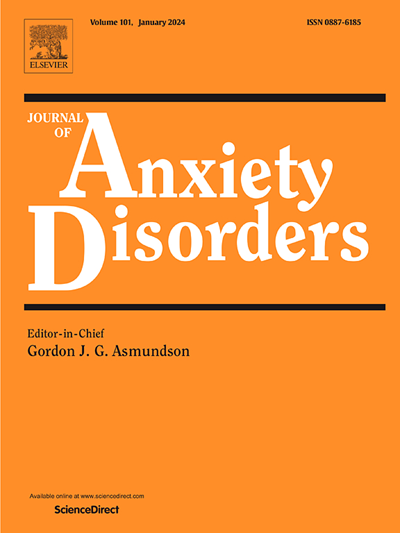通过注视引导注意力预测焦虑症状:在现实世界的言语任务中对青少年的移动眼动追踪研究
IF 4.5
2区 医学
Q1 PSYCHIATRY
引用次数: 0
摘要
青春期是焦虑症状急剧增加的关键时期,特别是在青春期女孩中。确定导致焦虑症状的潜在可改变的风险因素可能对减轻青少年的焦虑症状和障碍至关重要。注意偏差是一组涉及发展和维持焦虑症的认知风险因素。然而,之前的研究仍然是混合的,关于什么样的注意力偏差模式是青少年发展焦虑风险的特征。此外,先前的文献在很大程度上依赖于注意力的间接测量(如反应时间)和低生态效度的任务。本研究调查了对社会评价反馈的关注对青春期女孩并发和预期焦虑症状的影响(n = 90,基线Mage = 12.31, SD = 0.83)。本研究使用一种新颖的语音任务和移动眼动追踪技术来评估青少年在生态有效的环境中每天遇到的凝视注意力。我们假设,对潜在的批判性社会评价反馈保持警惕、回避以及警惕-回避结合的青少年会报告更大的并发和预期焦虑症状。我们还探讨了注视导向注意力与积极社会反馈之间的关系。与我们的假设相反,在控制基线焦虑症状的情况下,表现出最初和持续回避潜在批评性社会反馈的青少年在三年后报告了最大的焦虑。研究结果强调了在现实世界的社会威胁情境中,回避在促进和维持焦虑方面的重要性。研究结果还强调了使用可靠的方法和在现实环境中研究导致青少年焦虑症状的注意力偏差的价值。本文章由计算机程序翻译,如有差异,请以英文原文为准。
Predicting anxiety symptoms through gaze-directed attention: A mobile eye-tracking study of adolescents during a real-world speech task
Adolescence is a key period in which anxiety symptoms dramatically increase, particularly among adolescent girls. Identifying potentially-modifiable risk factors that contribute to anxiety symptoms may be critical to mitigate anxiety symptoms and disorders among youth. Attention biases are one set of cognitive risk factors implicated in the development and maintenance of anxiety disorders. Yet previous research remains mixed as to what pattern of attention bias characterizes adolescents at-risk for developing anxiety. Further, prior literature has largely relied on indirect measures of attention (e.g., reaction time) and tasks with low ecological validity. The present study investigated how attention to social evaluative feedback contributed to concurrent and prospective anxiety symptoms in adolescent girls (n = 90, baseline Mage = 12.31, SD =.83). The present study used a novel speech task and mobile eye-tracking technology to assess gaze-directed attention in an ecologically valid context that adolescents encounter daily. We hypothesized that adolescents who engage in vigilance, avoidance, and the combination of vigilance-avoidance of potentially critical social evaluative feedback would report greater concurrent and prospective anxiety symptoms. We also explored the association between gaze-directed attention to positive social feedback. Contrary to our hypotheses, adolescents who exhibited both initial and sustained avoidance of potentially critical social feedback reported the greatest anxiety three-years later, controlling for baseline anxiety symptoms. Findings highlight the importance of avoidance in real-world socially threatening scenarios in contributing to and maintaining anxiety. Findings also highlight the value of studying attention biases that contribute to anxiety symptoms among adolescents using reliable methods and in real-world contexts.
求助全文
通过发布文献求助,成功后即可免费获取论文全文。
去求助
来源期刊

Journal of Anxiety Disorders
Multiple-
CiteScore
16.60
自引率
2.90%
发文量
95
期刊介绍:
The Journal of Anxiety Disorders is an interdisciplinary journal that publishes research papers on all aspects of anxiety disorders for individuals of all age groups, including children, adolescents, adults, and the elderly. Manuscripts that focus on disorders previously classified as anxiety disorders such as obsessive-compulsive disorder and posttraumatic stress disorder, as well as the new category of illness anxiety disorder, are also within the scope of the journal. The research areas of focus include traditional, behavioral, cognitive, and biological assessment; diagnosis and classification; psychosocial and psychopharmacological treatment; genetics; epidemiology; and prevention. The journal welcomes theoretical and review articles that significantly contribute to current knowledge in the field. It is abstracted and indexed in various databases such as Elsevier, BIOBASE, PubMed/Medline, PsycINFO, BIOSIS Citation Index, BRS Data, Current Contents - Social & Behavioral Sciences, Pascal Francis, Scopus, and Google Scholar.
 求助内容:
求助内容: 应助结果提醒方式:
应助结果提醒方式:


